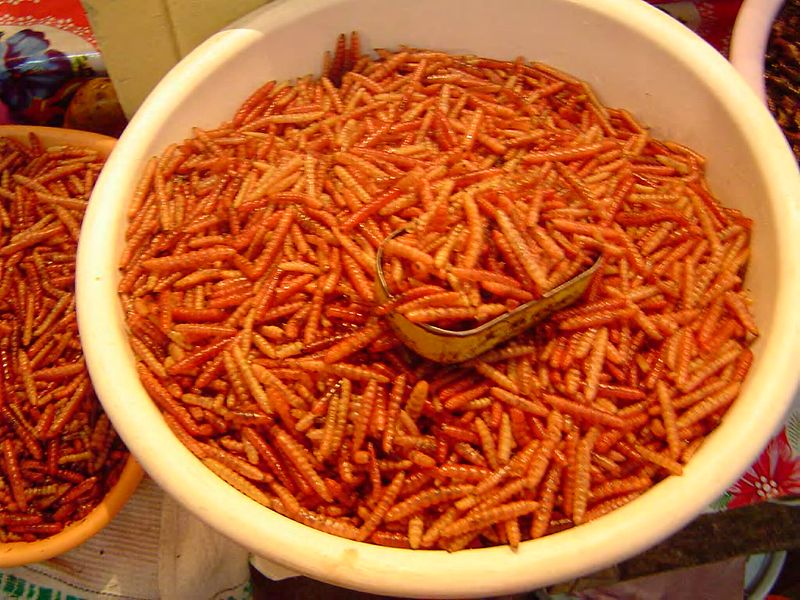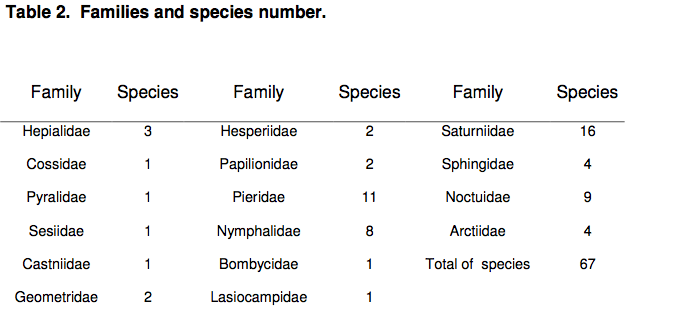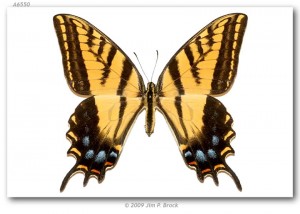![]() Отсекогаш сум се знае дека во многу места на светот, особено надвор од тепани песна, гасеници на пеперутки и пеперутки се на менито. Од Африка да Австралија има десетици видови кои може да имаат доволно добар вкус за да бидат разумно за јадење, па дури и вкусни. Но, овде, во САД, инсектите ретко или некогаш доаѓаат на нашите маси (барем не според нашите сознанија) – но повремено во нашите шишиња. Сигурен сум дека многумина од вас го виделе црвот на дното од шишето текила: која всушност е гасеницата на молецот Косид Хипотпа агавис. Дури слушнав извештаи дека мексиканските работници мигранти копаат домашни растенија на нивниот одмор за ручек за да ги грицкаат големите розови ларви на сроден молец; веројатно во родот Комедија. И покрај моето претходно знаење, Бев малку изненаден од една неодамнешна статија во која се дискутира за огромната разновидност на Лепидоптерите што се користат како главен извор на храна низ Мексико..
Отсекогаш сум се знае дека во многу места на светот, особено надвор од тепани песна, гасеници на пеперутки и пеперутки се на менито. Од Африка да Австралија има десетици видови кои може да имаат доволно добар вкус за да бидат разумно за јадење, па дури и вкусни. Но, овде, во САД, инсектите ретко или некогаш доаѓаат на нашите маси (барем не според нашите сознанија) – но повремено во нашите шишиња. Сигурен сум дека многумина од вас го виделе црвот на дното од шишето текила: која всушност е гасеницата на молецот Косид Хипотпа агавис. Дури слушнав извештаи дека мексиканските работници мигранти копаат домашни растенија на нивниот одмор за ручек за да ги грицкаат големите розови ларви на сроден молец; веројатно во родот Комедија. И покрај моето претходно знаење, Бев малку изненаден од една неодамнешна статија во која се дискутира за огромната разновидност на Лепидоптерите што се користат како главен извор на храна низ Мексико..
(од Википедија)
This study recently published in the Journal of Ethnobiology outlines a total of 67 видови regularly utilized by indigenous populations of Mexico. 67! Even more stunning is the occasional use of adults and even what I would consider as noxious species. When comparing similar studies this is the largest and most comprehensive of its kind and involved first hand field research. Previous authors cited have only done limited field work or relied strictly on bibliographic work, limiting their results. Само 17 of the 31 Mexican states were covered, leaving many areas still unexplored but likely to further increase the number of edible Lepidoptera. Most importantly you can infer from these results that world wide consumption of Lepidoptera is greatly under reported. It doesn’t come as too surprising however since large juicy caterpillars are protein rich and easily harvested. Some even come in a a ready made pouch. (As an aside, these social lepidoptera are very interesting and form canvass like tents that are nearly impenetrable).
I wish there was an accompanying cookbook and more lengthy descriptions of how these caterpillars are prepared. They do mention that the two most common methods are a simple pan fry or boiled in salted water. I would imagine that some animals require a special technique, or at the very least chased with something better tasting. But like all foods, some have risen to the level of delicacy. На “white agave worm” (Comadia redtenbacheri) is canned and exported to the US, selling for $250 per kilo or $50 a can!
The authors note that seven of the sixty seven are surprisingly eaten as adults; including the Monarch butterfly which is famously noxious. How these are palatable is beyond me, but no mention is given as to how or why they are prepared. Also eaten as an adult is the multi-tailed swallowtail (подолу, од Пеперутки на Америка). I see these in the field all the time in Arizona so maybe I’ll have to grab one for a snack… But watch out for the caterpillars because they are reported to “make the heart stop”.
Another surprising find is the use of Hemileuca и Hylesia caterpillars. These stout Saturniidae are covered in dense urticating hairs or spines that can cause horrible rashes (somewhat graphic image). How are these prepared? The spines of Hemileuca are tough and not simply hairs that can be brushed or burned off, and the hairs of Hylesia are reported to cause contact dermatitis!
I’m a pretty adventurous eater and I wouldn’t say no to most of these leps. Подлец, if you put it on a taco I’d be done before you could tell me what was in it. But this study is important in the understanding of the utility and importance of Lepidoptera and insects in the daily lives of cultures. Preservation of diversity doesn’t just help keep pretty butterflies in the air, but meals on the table.
Референци
ILLGNER, P., & NEL, Тоа. (2000). The Geography of Edible Insects in Sub-Saharan Africa: a study of the Mopane Caterpillar The Geographical Journal, 166 (4), 336-351 DOI: 10.1111/j.1475-4959.2000.tb00035.x
Ramos-Elorduy J, Moreno JM, Vazquez AI, Landero I, Oliva-Rivera H, & Camacho VH (2011). Edible Lepidoptera in Mexico: Geographic distribution, ethnicity, economic and nutritional importance for rural people. Journal of ethnobiology and ethnomedicine, 7 (1) PMID: 21211040




Not only a cookbook, but a guide to finding, identifying them and understanding their place in the local ecosystem, бербата, and pre-prep would be useful.
Control pest species and feed people! I’d try it.
Insects are the Food of the Future, Dutch Scientists Arnold van Huis say http://bit.ly/hhagMJ
I have several articles on entomophagy in Zambia, Southern Africa, that I can contribute to your Webpage if you are interested.
Prof. Keith J. Mbata
Department of Biological Sciences
P.O. Box 2379
Lusaka
ZAMBIA
[…] This post was mentioned on Twitter by Erik van Erne, Agrarisch Nieuws, Flipboard Science, sciseekfeed, The Gam and others. The Gam said: Ентомофагија: молци за вечера http://goo.gl/fb/zCpNG […]
[…] vegetables in your diet, but what about insects? Chris Grinter of The Skeptical Moth reports on the widespread consumption of butterflies and caterpillars in Mexico, providing readers with a look at some unique cultural culinary […]